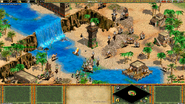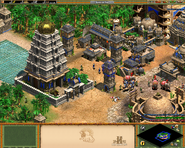Template:Infobox CivThe Indians are a South Asian civilization featured in Age of Empires II HD: The Forgotten. They are based on Medieval and Mughal India situated in the Indian subcontinent.
India is one of the world's most ancient civilizations that has existed for millennia, and Medieval India was also influenced by the introduction of Islam. Indian armies historically depended on elephants, so to depict this, they have the Elephant Archer as a unique unit. The northern part of Medieval India also introduced camels as a vital part of their military force, so they also have a unique upgrade to the Heavy Camel, the Imperial Camel, while their team bonus also provides camels with an attack bonus against buildings, and their own camels also have more armor. India in the Middle Ages was a highly advanced civilization that learned the secrets of gunpowder from the Chinese and the Saracens, so to reflect this, their Hand Cannoneers are stronger than other civilizations because of their Imperial unique technology, Shatagni, which increases Hand Cannoneer range by one. Indian kingdoms were very wealthy and their Castle Age unique technology, Sultans, reflects this by increasing all their gold income by 10%, including relics and Trade Carts. Fishing was an important part of the Indian economy, so their Fishermen work faster and carry more food. Thanks to their steady population growth over the centuries, Indian villagers get cheaper as the civilization advances through the ages.
Description
Wage war on the colorful Indian subcontinent, the lands of a thousand kingdoms and sultanates. Put vast armies under your command, spiced up with Camels and Elephants to terrify the invaders of your homeland. Prosperity is hard fought, yet, your culture will stand the test of time.
Overview

The Wonder of the Indians prior to Rise of the Rajas, the Gol Gumbaz
The Indians are a booming Camel and Gunpowder civilization who can become very strong in the Imperial Age. The Indians have all the Archery Ranges' units available to them and they are able to research all archer upgrades. They can also create the Hand Cannoneer which benefits from the Imperial Age unique technology, Shatagni, which increases their Hand Cannoneers range by one. The Elephant Archer is a quite formidable unique unit created in the Castle, and is a powerful archer mounted on an elephant that can be used to soak damage in place of Knights. The Barracks also has Champion, Halberdier and their infantry gets all technologies except Plate Mail Armor. The Indian's Stable obtains the Hussar, however doesn't have any units from the Knight line, but they nullify this with their stronger Camels, who benefit from all the Stable and Blacksmith upgrades plus the bonuses to armor and attack versus buildings. They are the only civilization to have the powerful Imperial Camel, a unique unit which is the upgrade for the Heavy Camel. The Monastery isn't too bad, but lacks Atonement, Heresy and Faith. The Siege Workshop is not as good as compared to other civilizations because it lacks Siege Onager, Siege Ram and Heavy Scorpion, but it has the Bombard Cannon The Indians should be fine at the Dock, only lacking Fast Fire Ship and Shipwright. The Indians have a robust economy, as their Villagers are cheaper than other civilizations, due to the fact that the Villagers get incrementally cheaper as they advance through the Ages and they (the villagers) fish much faster than other civilizations. Their economy really begins to shine from the Castle Age as they can research their first unique technology, Sultans, which increases all their gold income by 10%, including Relics and trade units. They also have all the economic upgrades except Crop Rotation. Thanks to their unique Camel Upgrade, the Indians sparkle against civilizations that rely heavily on Cavalry, like the Franks, Huns and Persians. However, due to the lack of Heresy and dependence of expensive units (such as the mentioned Elephant Archer, Imperial Camel, and Hand Cannoneers), the Indians are vulnerable to civilizations with strong Monks, such as the Aztecs and Spanish.
Unique Unit: Elephant Archer (Heavy mounted archer riding an elephant, good HP and pierce armour), Imperial Camel (Anti-Cavalry Camel upgrade)
Unique Technologies: Sultans (All gold production +10% faster), Shatagni (Hand Cannoneers get +1 range)
Civilization bonuses
- Fishermen work 15% faster and carry +15 food
- Villagers cost -5% Dark Age, -10% Feudal Age, -15% Castle Age, -20% Imperial Age
- Camels +1 melee armor/+1 pierce armor
- Team Bonus: Camels +6 attack vs. buildings.
Changes in the African Kingdoms
- Villagers cost -10% Dark Age, -15% Feudal Age, -20% Castle Age, -25% Imperial Age (5% more per age)
- Receive Guilds
- Receive Ring Archer Armor
- The Elephant Archer line costs 10 less food.
- Elephant Archer gets +30 HP; their health is now 280
- Elite Elephant Archer -20 HP; their health is now 330
- Elite Elephant Archer -1 pierce armor
Changes in Rise of the Rajas
- New unique architecture style
- Arbalest removed from the technology tree since patch 5.5
In-game dialogue language
Until The African Kingdoms expansion, the Indians used their namesake civilization's dialogue in Age of Empires III, which is anachronistic for the time frame as Villagers are using the English greeting "Hello!".
After The African Kingdoms expansion, Indian units speaks in a different dialogue, using Hindi.
- Hamla (Attack)
- Lakadhara (Lumberjack)
- Namaste (Greetings)
- Karunga (I will do it)
- Shikari (Hunter)
- Nirmata (Builder)
- Samajh Gaya (Understood)
- Turant (Right away)
- Haan (Yes)
- Kisan (Farmer)
- Khanik (Miner)
- Chara Khojne Wala (Forager)
AI player names
- Akbar - popularly known as Akbar I and later Akbar the Great, was the third Mughal emperor, who reigned from 1556 to 1605.
- Babur - born Ẓahīr-ud-Dīn Muhammad, was an invader from Central Asia who, following a series of setbacks, finally succeeded in laying the base for the Mughal dynasty in the Indian subcontinent and became the first Mughal emperor.
- Bappa Rawal - a semi-legendary ruler of the Mewar region in Rajasthan, India. The bardic chronicles describe him as a member of the Guhila clan of Rajputs, and some of these describe as the founder of his dynasty. Several historians have identified him with Kalabhoja, a ruler of the Mewar branch of the Guhilas.
- Humayun - the second emperor of the Mughal Empire, who ruled over territory in what is now Afghanistan, Pakistan, and parts of northern India from 1531–1540 and again from 1555–1556.
- Iltutmish - the third ruler of the Delhi Sultanate, belonging to the Mamluk dynasty. Iltutmish consolidated the position of the sultanate in the Indian subcontinent.
- Man Singh I - the Rajput Raja of Amber, a state later known as Jaipur in Rajputana. He was a trusted general of the Mughal emperor Akbar, who included him among the Navaratnas, or the nine gems of the royal court.
- Sultan Balban - Ghiyas ud din Balban (reigned: 1266–1287) the ninth sultan of the Mamluk Dynasty reigned: 1266–1287 dynasty of Delhi.
- Sultan Ala-ud-din Khilji - the second and the most powerful ruler of the Khalji dynasty of Delhi Sultanate in the Indian subcontinent.
Gallery
Trivia
- Prior to the release of Rise of the Rajas, the Indians shared the same architecture style as the Middle Eastern civilizations.
- The unique architecture style of the Indians featured in Rise of the Rajas is based on the Vijayanagara architecture.
- The bottom middle of Indians player's navigation bar shows the image of a lion in front of sun. The image is based from the flag of Mughal Empire.
- The Indians are both the first civilization to officially change their architecture design to a different style in a later update and are currently the only civilization in Age of Empires II to have a unique architecture set only used by a single civilization. Previously, the Italians Mediterranean design was unique to only themselves prior to the release of African Kingdoms and the inclusion of the Portuguese.
- The new Indian Architecture was designed by modder "Tzontlimixtli", who worked with Forgotten Empires during the development of Rise of the Rajas.
- Prior to the release of Rise of the Rajas and during the release of African Kingdoms and Patch 4.4, an "Official Mod" of an earlier version of Tzontlimixli's Indian Architecture was released on the Steam Workshop by Tzontlimixli and "Cysion" of Forgotten Empires. The Indians were also given duplicate versions of the Middle Eastern design, separate from the remaining civilizations that used it, for the sole purpose of using the modded version. The older version can still be found on the Steam Workshop
Video overview
Note: This video is outdated. This shows the Indians with the Middle Eastern architecture. They have their own unique architecture as of the release of Rise of the Rajas.



